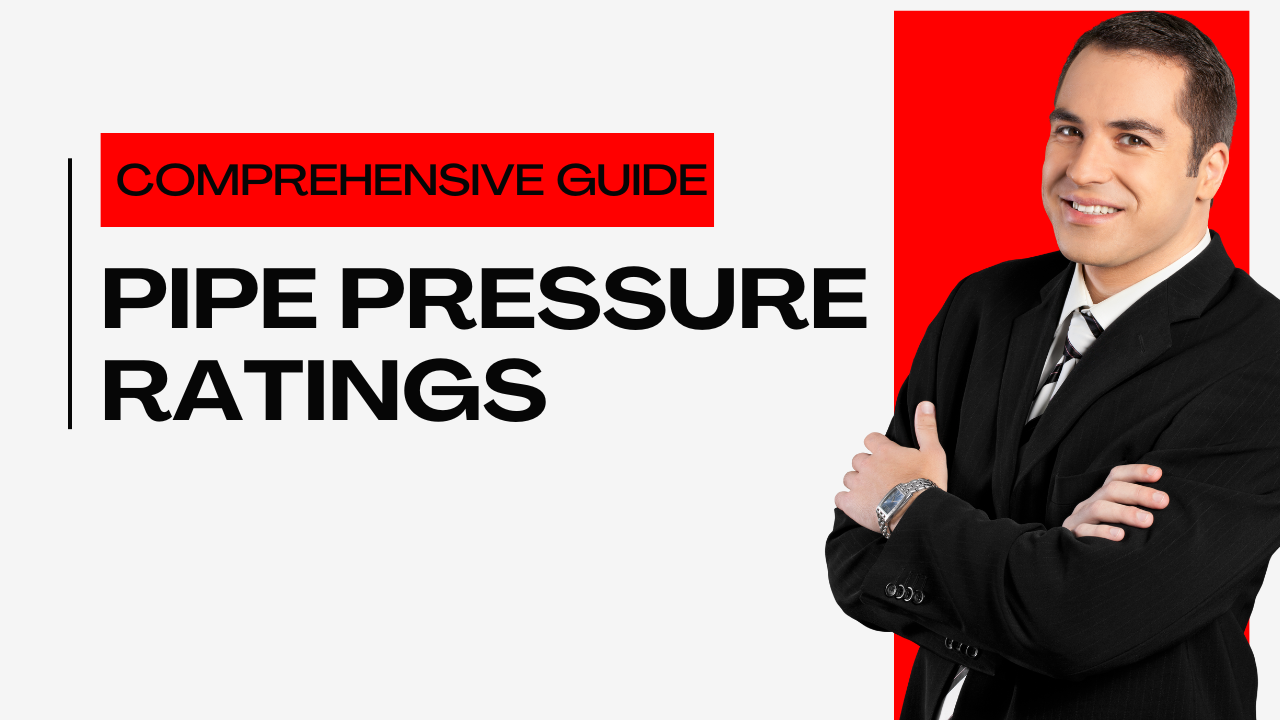Introduction
In the intricate network of industries that make up our modern world, the concept of Pipe Pressure Ratings plays a pivotal role. Whether it’s transporting liquids, gases, or other substances, understanding and managing pipe pressure ratings are crucial for the safety and efficiency of operations. This comprehensive guide dives deep into the world of pipe pressure ratings, covering everything from the basics to advanced calculations, industry standards, practical applications, and best practices.
Table of Contents
Don’t miss the Detailed course on 7 Modules for Piping Codes & Standards
Enrollment Link
Basics of Pipe Pressure Ratings
Pipe Pressure Ratings Defined
At its core, a pipe pressure rating is a measure of the maximum allowable working pressure a pipe can withstand. This rating ensures that the pipe can handle the pressures and stresses imposed by the fluids or gases flowing within it without compromising its structural integrity. Key terms in this context include working pressure, which is the pressure a pipe can continuously handle, and burst pressure, which refers to the pressure that leads to pipe failure.
Role of Pipe Materials
The choice of pipe material significantly influences its pressure rating. Different materials possess varying mechanical properties, which determine their strength and ability to withstand pressure. For instance, steel pipes are known for their high strength and pressure handling capabilities, while plastic pipes like PVC and HDPE are favored for their corrosion resistance and versatility.
Similar Articles related to Pipe
| Topic | Weblink | Topic | Weblink |
|---|---|---|---|
| Pipe Insulation Materials | Link | ASME B36.10 | Link |
| Piping Codes & Standards | Link | Non-Metallic Pipes | Link |
| Pressure-Temperature Ratings | Link | Pipe Standards & Specifications | Link |
| Pipes for Different Fluids | Link | Pipe Coatings & Linings | Link |
| Pipe Materials Selection Guidelines | Link | Corrosion & Pipe Protection | Link |
| High-Temperature Pipes | Link | Pipe Dimensions & Sizes | Link |
| Pipe Manufacturing Processes | Link | Types of Pipes in Piping Systems | Link |
| Pipe Thickness Calculations | Link | Pipe Inspection & Testing | Link |
Factors Affecting Pipe Pressure Ratings
Temperature Considerations
Temperature is a critical factor that impacts the pressure handling capacity of pipes. As temperatures rise, the material’s properties can change, affecting its strength and ductility. It’s important to factor in the operating temperature when determining the appropriate pressure rating for a given pipe material.
Pipe Diameter and Thickness
The diameter and thickness of a pipe directly affect its pressure capacity. Larger diameter pipes with thicker walls generally have higher pressure ratings. This is due to the increased cross-sectional area that can distribute the applied pressure over a larger surface, minimizing stress concentration.
Corrosion Resistance and Pipe Pressure Ratings
Corrosion can weaken pipes over time, reducing their pressure handling capabilities. Choosing a corrosion-resistant material or applying protective coatings can extend the lifespan and maintain the pressure rating of pipes in corrosive environments.
Impact of Pipe Fittings and Joints
Pipe fittings and joints can create areas of stress concentration, potentially leading to weak points in the piping system. Proper selection and installation of fittings and joints are crucial to ensure that the pressure rating of the entire system remains consistent.
Don’t miss the Detailed course on 7 Modules for Piping Codes & Standards
Enrollment Link
Pipe Materials and Pressure Ratings
Metal Pipes
Metal pipes are widely used in industries such as oil and gas, construction, and manufacturing. Steel pipes, in particular, are known for their robustness and high-pressure capacity. Stainless steel offers excellent corrosion resistance, making it suitable for various applications.
Plastic Pipes
Plastic pipes, including PVC (polyvinyl chloride) and HDPE (high-density polyethylene), are valued for their lightweight nature and resistance to corrosion and chemicals. Their pressure ratings vary based on factors such as material type and manufacturing method.
Comparative Analysis
Comparing pressure ratings across different materials involves considering factors like material strength, temperature resistance, and long-term durability. This analysis helps in making informed decisions when selecting pipes for specific applications.
Standards and Codes
Industry Standards and Their Significance
Industry standards, such as ASME B31.3, ASTM, and ISO, provide guidelines for designing, manufacturing, and using pipes that adhere to specific pressure ratings. These standards ensure uniformity, safety, and interoperability across different systems and applications.
Standard Development and Maintenance
Standards are developed through collaboration between experts in the field, and they are regularly updated to incorporate new technologies and research findings. Adhering to the latest standards is crucial for maintaining safe and reliable piping systems.
Calculating Pipe Pressure Ratings
Equations and Methodologies
Calculating pipe pressure ratings involves considering multiple factors, including material strength, design factor, temperature, and more. Various equations and methodologies, such as the Barlow’s formula, aid in determining the appropriate pressure rating for a given pipe.
Factors Involved in Calculations
Material properties play a significant role in pressure rating calculations. The yield strength of the material, along with the design factor that accounts for uncertainties, influences the final pressure rating. Temperature variations also impact the calculations.
Practical Examples
To illustrate pressure rating calculations, let’s consider an example: calculating the pressure rating for a stainless steel pipe in a high-temperature environment. By plugging in the relevant values into the appropriate equations, engineers can arrive at a pressure rating that ensures safe operation.
Don’t miss the Detailed course on 7 Modules for Piping Codes & Standards
Enrollment Link
Types of Pipe Pressure Ratings
Differentiating Pressure Ratings
Pressure ratings extend beyond pipes; they also apply to valves and fittings. Understanding the distinctions between these types of pressure ratings is crucial for maintaining the integrity of the entire system.
Classes and Schedules
Classes and schedules categorize pressure ratings based on different criteria, such as pressure-temperature combinations. Classes are typically used for flanges, while schedules are used for pipes. These classifications aid in selecting components that align with the intended pressure requirements.
Pressure Ratings for Different Pipe Types
Different pipe manufacturing methods, such as seamless, ERW (electric resistance welding), and LSAW (longitudinal submerged arc welding), can influence pressure ratings. Seamless pipes, for instance, often have higher pressure ratings due to their uniform structure.
Safety Margins and Pressure Fluctuations
Importance of Safety Margins
Selecting a pressure rating with an appropriate safety margin is crucial to account for unexpected pressure spikes, temperature variations, and other uncertainties. A safety margin helps prevent pipe failure and ensures the system’s longevity.
Managing Pressure Fluctuations
Piping systems frequently experience pressure fluctuations due to changes in flow rate, temperature, or other factors. Proper system design, including the use of pressure relief valves and surge suppressors, helps manage these fluctuations and protects the system from damage.
Real-World Consequences
Instances of inadequate safety margins and pressure rating selection have led to catastrophic failures. Case studies, such as pipeline ruptures, emphasize the dire consequences of underestimating the importance of safety margins.
Application in Different Industries
Oil and Gas Industry
The oil and gas industry operates in high-pressure environments. Proper pipe pressure rating selection is paramount to prevent accidents, leaks, and equipment failures that can have severe environmental and financial repercussions.
Water Supply and Distribution Systems
Water supply systems need to balance pressure requirements to ensure consistent water flow to consumers. Accurate pressure rating selection in both distribution and transmission systems guarantees reliable service delivery.
Chemical Processing Industry
Chemical processing involves handling corrosive and often hazardous fluids under pressure. Selecting pipes with appropriate pressure ratings, along with materials resistant to chemical corrosion, is critical to maintaining operational safety.
Construction and Infrastructure
In construction, pipe pressure ratings are essential for structural integrity. Piping systems in buildings, bridges, and other infrastructure projects must withstand pressure loads to ensure the safety of occupants and the longevity of the structure.
Don’t miss the Detailed course on 7 Modules for Piping Codes & Standards
Enrollment Link
Testing and Quality Assurance
Ensuring Compliance through Testing
Non-destructive testing methods, such as ultrasonic testing and radiographic inspection, are used to verify that pipes meet their specified pressure ratings. These tests identify defects or weaknesses that could compromise the pipe’s pressure handling capacity.
Quality Control in Manufacturing
Manufacturers play a pivotal role in maintaining pressure integrity. Quality control processes, from material selection to production and inspection, help ensure that pipes meet the specified pressure ratings and adhere to industry standards.
Consequences of Using Incorrect Pressure Ratings
Using pipes with incorrect pressure ratings can lead to leaks, bursts, and system failures. These incidents can result in costly downtime, environmental hazards, and even loss of life. Strict adherence to pressure ratings is a critical safeguard.
Factors Beyond Pressure Ratings
Environmental Considerations
Environmental conditions, such as soil corrosiveness and exposure to elements, can impact the longevity of pipes and their pressure handling capacity. Proper coatings and corrosion protection strategies are essential in such scenarios.
Maintenance Practices
Routine maintenance, including inspections, cleaning, and corrosion monitoring, helps preserve the pressure handling capability of pipes over time. Proactive maintenance reduces the likelihood of sudden failures and ensures continuous system performance.
Future Trends
Advancements in materials science and technology are leading to innovations in pipe manufacturing and pressure management. Smart sensors, predictive analytics, and enhanced materials are shaping the future of pipe pressure ratings.
Case Studies
Learning from Incidents
Examining past incidents caused by inadequate pressure rating consideration highlights the disastrous consequences of oversight. Case studies, such as the BP Deepwater Horizon oil spill, serve as sobering reminders of the importance of prioritizing pressure management.
Success Stories
Conversely, success stories showcase industries that have embraced proper pressure management practices. These stories demonstrate how careful consideration of pressure ratings can lead to safe, efficient, and sustainable operations.
Best Practices for Selecting and Using Pipes
Step-by-Step Guide
A systematic approach to selecting pipe pressure ratings involves assessing factors like fluid type, temperature, and operating conditions. Consulting with engineers and experts ensures that the chosen pressure rating aligns with the intended application.
Expert Consultation
Engaging with professionals who specialize in pipe engineering and pressure management can provide invaluable insights. Their expertise helps in making informed decisions that prioritize safety and performance.
Ongoing Inspection and Monitoring
Even after installation, regular inspections and monitoring are essential to verify that pipes continue to meet their pressure ratings. This proactive approach minimizes the risk of unexpected failures and ensures the long-term reliability of the system.
Don’t miss the Detailed course on 7 Modules for Piping Codes & Standards
Enrollment Link
Conclusion
In the intricate web of industries that power our world, pipe pressure ratings stand as guardians of safety and efficiency. Understanding the interplay between materials, factors, and calculations enables us to make informed decisions that safeguard lives, resources, and the environment. From the oil fields to water treatment plants, from chemical plants to construction sites, the principles of pipe pressure ratings ensure the reliability and longevity of our critical infrastructure. By embracing the knowledge shared in this guide and prioritizing proper pressure management, we pave the way for a future built on the foundations of safety and progress.
Frequently Asked Questions (FAQs) About Pipe Pressure Ratings
1. What exactly are pipe pressure ratings?
Pipe pressure ratings refer to the maximum allowable working pressure that a pipe can withstand while maintaining its structural integrity. These ratings ensure safe and efficient operation by preventing overpressurization and potential failures within a piping system.
2. How do temperature changes impact pipe pressure ratings?
Temperature changes can significantly affect the material properties of pipes, potentially altering their strength and ductility. Elevated temperatures can reduce a pipe’s pressure handling capacity. It’s essential to consider operating temperatures when selecting the appropriate pipe material and pressure rating.
3. What role do pipe fittings and joints play in pressure ratings?
Pipe fittings and joints can create stress concentration points within a piping system. If not chosen and installed correctly, they can undermine the overall pressure handling capability of the system. Proper selection, installation, and inspection of fittings and joints are crucial to maintain consistent pressure ratings.
4. Are there different pressure ratings for different pipe materials?
Yes, different pipe materials have varying mechanical properties that influence their pressure handling capabilities. Metal pipes, such as steel and stainless steel, are known for their high-pressure capacities, while plastic pipes like PVC and HDPE offer corrosion resistance and flexibility with different pressure ratings.
5. How can industries ensure they’re using pipes with the correct pressure ratings?
Industries should adhere to industry standards and codes that provide guidelines for selecting and using pipes with appropriate pressure ratings. Collaborating with engineers and experts, conducting regular inspections, and employing non-destructive testing methods can help ensure that pipes are correctly rated and meet safety requirements.
Recommended courses (Published on EPCLand)
- Basics of Piping Engineering
- Piping Layout Engineering
- Piping Material Engineering
- Piping Stress Analysis
- Complete Course on Piping Engineering
- Material Requisitions
- Piping Material Specifications
- Valve Material Specifications
Don’t miss the published articles on following:
Related Video
Attempt Quiz
Question 1:
What is the primary purpose of pipe pressure ratings?
Explanation: Pipe pressure ratings are used to establish the maximum allowable pressure that a pipe can safely handle without risking failure or leakage.
Question 2:
What is the typical unit of measurement for pipe pressure ratings?
Explanation: The typical unit of measurement for pipe pressure ratings is pounds per square inch (psi), which represents the pressure exerted on a unit area of the pipe’s cross-section.
Question 3:
Which factor does NOT typically affect the pipe pressure rating?
Explanation: Pipe color does not typically affect the pipe pressure rating. The material, diameter, and operating temperature are important factors that influence the pressure rating.
Question 4:
What is the importance of understanding pipe pressure ratings?
Explanation: Understanding pipe pressure ratings is crucial to prevent overloading pipes, which can lead to catastrophic failures and safety hazards. It ensures that the pipe is operated within safe pressure limits.
Question 5:
What do the pressure ratings on a pipe specify?
Explanation: The pressure ratings on a pipe specify the maximum allowable pressure that the pipe can handle for safe operation without risk of failure or leakage.



